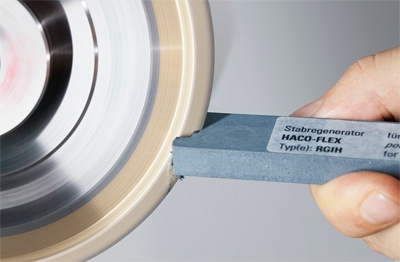
"The HACO-FLEX regenerator is not a new product," says Peter Haefeli, coowner of long-established grinding tools manufacturer Haefeli, when asked how long the product has been on the market. "Although this exceptionally practical tool has been part of our range for almost 50 years, it looks a bit different these days and is now even more effective."
Anyone who works with CBN or diamond grinding wheels or grinding pencils knows that the precise geometry and bite level of the abrasive surface play a decisive role in determining the end result. Alongside the geometric alignment, it is therefore crucial to regularly regenerate the abrasive surface.
"If they are to truly bite, the abrasives used on a grinding wheel or pencil have to be positioned freely above the bonding material," explains Haefeli.
This makes sense. If the bonding material and the abrasive particles are on the same level, the wheel presses down more than it grinds, thus removing material, which is expensive and imprecise.
Haefeli offers HACO-FLEX regenerators to effectively regenerate grinding tools. They are available as either a disc or a stick, for all kinds of bonding materials and no more difficult to use than a standard eraser. The flexible HACO-FLEX is simply applied with pressure, either by hand or by machine, onto the grinding tool as it rotates without the use of a coolant.
Working just like an eraser, it frees the chip space on the grinding tool until the abrasive particles protrude above the bonding material by around a third (the optimum position). In no time at all, users can once again benefit from a grinding tool that bites.
"A conventional grindstone is far too hard and inflexible to get such a great result," points out Peter Haefeli. He recommends to his customers that they regularly regenerate their tools with HACO-FLEX for more precise grinding, shorter grinding times and longer service lives.
Contact Details
Related Glossary Terms
- abrasive
abrasive
Substance used for grinding, honing, lapping, superfinishing and polishing. Examples include garnet, emery, corundum, silicon carbide, cubic boron nitride and diamond in various grit sizes.
- coolant
coolant
Fluid that reduces temperature buildup at the tool/workpiece interface during machining. Normally takes the form of a liquid such as soluble or chemical mixtures (semisynthetic, synthetic) but can be pressurized air or other gas. Because of water’s ability to absorb great quantities of heat, it is widely used as a coolant and vehicle for various cutting compounds, with the water-to-compound ratio varying with the machining task. See cutting fluid; semisynthetic cutting fluid; soluble-oil cutting fluid; synthetic cutting fluid.
- cubic boron nitride ( CBN)
cubic boron nitride ( CBN)
Crystal manufactured from boron nitride under high pressure and temperature. Used to cut hard-to-machine ferrous and nickel-base materials up to 70 HRC. Second hardest material after diamond. See superabrasive tools.
- grinding
grinding
Machining operation in which material is removed from the workpiece by a powered abrasive wheel, stone, belt, paste, sheet, compound, slurry, etc. Takes various forms: surface grinding (creates flat and/or squared surfaces); cylindrical grinding (for external cylindrical and tapered shapes, fillets, undercuts, etc.); centerless grinding; chamfering; thread and form grinding; tool and cutter grinding; offhand grinding; lapping and polishing (grinding with extremely fine grits to create ultrasmooth surfaces); honing; and disc grinding.
- grinding wheel
grinding wheel
Wheel formed from abrasive material mixed in a suitable matrix. Takes a variety of shapes but falls into two basic categories: one that cuts on its periphery, as in reciprocating grinding, and one that cuts on its side or face, as in tool and cutter grinding.






